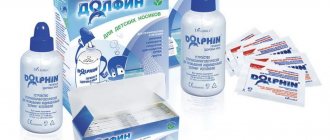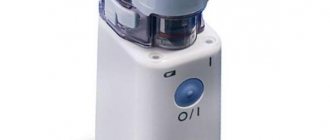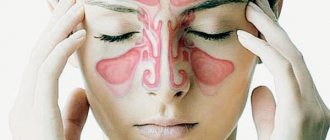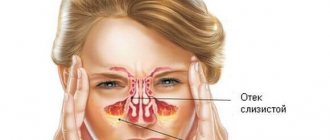What are complex nasal drops? Not everyone has the answer to this question. But it is quite simple - these are nasal drops, which are prepared according to an individual doctor’s prescription from several ingredients. Their preparation can be ordered from a pharmacy, performed directly by the prescribing doctor, or done independently at home. It should be noted that complex drops for sinusitis made in a pharmacy will be of higher quality than those made at home, since the pharmacist will be able to accurately measure the required amount of ingredients and mix them taking into account all the rules.
Efficiency of complex drops
It would seem that the pharmaceutical market provides enough of all kinds of remedies for the treatment of runny nose, sinusitis and other sinusitis. But otolaryngologists continue to prescribe complex drops to patients, relying on their experience of using them. Are such drugs effective?
Efficiency depends on several factors. Firstly, the doctor’s competence and his ability to correctly select the composition of the drops for each patient, taking into account the characteristics of the course of the disease, play an important role. Equally important is the patient’s willingness to strictly follow all the doctor’s instructions. If both of these factors coincide, then complex drops will almost always be more effective than ready-made pharmaceutical preparations for the nose.
If a person decides to self-medicate and chooses a prescription for drops on the Internet, on the advice of friends or from another source of information, then such treatment can lead to serious negative consequences. Therefore, only a doctor can recommend a recipe for complex drops and their use.
What are turundas and why are they used?
Essentially, it is a cotton, gauze or combination tampon, twisted into a thin, dense roller, which is soaked in a medicinal mixture and screwed deep into the nasal passage for a certain time. Turundas can be used to directly affect the affected nasal mucosa.
Therapy with turundas in the nose for sinusitis is especially indicated, since such internal lotions ensure prolonged contact of drugs with the mucous membrane of the maxillary sinuses, bringing recovery closer.
Placing a turunda with a medicinal substance allows you to:
- soften and remove accumulated mucus;
- draw out purulent contents from the maxillary sinuses;
- make breathing easier;
- relieve swelling of the mucous membrane;
- act directly on the source of infection.
The use of tamponing the nasal passages with turundas containing medicinal substances allows the latter to act directly at the site of inflammation, which makes them indispensable for upper respiratory tract infections. Their use can be considered as a full-fledged method of treating sinusitis.
The duration of the procedure must be observed, which may depend on the drug used or their combination. If you do not withstand the required time, then the effectiveness of the procedure may be reduced, but if, on the contrary, you overdo it, then undesirable consequences may occur in the form of a burn of the mucous membrane, its atrophy.
3 ways to twist turundas - making blanks
When treating sinusitis with turundas, you need to learn how to use them. Ear sticks are not suitable for many people, especially children - they need soft cushions. When making a cotton swab, the head is small and wide, and the swab should act along the entire length of the nasal passage.
For blanks, use cotton wool, cotton pads, bandages or gauze. Materials must be sterile. We recommend 3 easy ways to twist turundas:
- tightly wrap a fluffy piece of cotton wool onto a thin stick, then wrap it in one or two layers with gauze or a bandage;
- We divide the cotton pad into 2 layers, twist each one tightly, then twist them together, like a spiral, until they give a stable shape;
- We moisten a piece of bandage with water, fold it and twist it in a spiral, as if squeezing it, until it takes the desired shape.
For children we use cotton pads without a base, for adults we use any, the main thing is that they correspond to the size of the nasal passage.
Not everyone will be able to make a turunda the first time, you need to practice. After 2 - 3 attempts the process will improve. It is worth winding the blanks in advance with hands that have been cleanly washed and then rubbed with an antiseptic. It should be stored in a tightly closed jar, which must first be doused with boiling water or steam, then dried.
Advantages and disadvantages
Like any drug, complex drops have their own advantages and disadvantages. Their ratio may vary depending on the composition of the drops.
Advantages:
- Selection of the components of the drops on an individual basis, which allows you to use the most effective medications for a particular case. This also avoids the use of ingredients that are known to cause allergic reactions in the patient.
- Complex drops are often several times cheaper than combined preparations made in factories.
- High efficiency due to the targeted action of the drug.
- The composition of the drops may change as the course of the disease changes.
- The components for making drops are available to everyone.
- Most complex drops can be prepared at home.
Such medications also have quite a few disadvantages:
- Clinical studies of complex drops have not been conducted, which means it is impossible to assess all the risks of their use.
- There are a small number of pharmacies with a production department where drops can be made according to individual recipes. This reduces the availability of such funds for patients, especially those living in small towns or villages.
- In the process of self-preparing at home, serious mistakes are possible (for example, incorrectly measured components), which will negatively affect the treatment.
- Most of the ingredients used are not intended for use in the nose according to official medicine.
- Due to the introduction of additional components, the number of possible side effects and contraindications increases.
Turunda in the nose for sinusitis: recipes and rules of use
Tampons (turundas) for the nose, used to treat sinusitis, are an effective way to influence the inflammatory processes of the nasal mucosa and maxillary sinuses. The active ingredient with which turundas were prepared may be different, but the purpose of all is the same: to relieve pain and symptoms of the disease.
How to make a turunda on the nose
Turundas or tampons are special devices made of bandages and gauze. To make them, you need to take a piece of the starting material, twist it in a spiral into a tight, dense roller of such a size that it fits into the nasal passage.
The tip of the finished turunda is moistened in a previously prepared medicinal solution or ointment, and the side with the medicine is inserted into the nose. Moreover, the lower part of the turunda should be outside, protruding slightly from the nose, so that it can be easily removed later.
If you don’t have a bandage or gauze on hand, you can use cotton wool or cosmetic cotton pads. In order to prepare turunda from cotton wool, you first need to fluff it and then roll it into a tube of the required size.
The time the tampon remains in the nose depends on the medicinal mixture chosen for it. Most of the recipes are folk remedies, but turundas are also used with ready-made pharmaceutical preparations.
In the video below you can see exactly how to make turundas and use them:
Among the advantages of using turundas for the treatment of sinusitis are the following:
- ease and simplicity of production at home;
- low cost;
- use in free time;
- simplicity of the procedure;
- preventing medication from leaking out of the nasal passage;
- direct contact of the therapeutic agent with the mucous membrane.
Action of turunda
Turundas are more effective than drops and nasal sprays, because the active substance is delivered directly to the mucous membrane. In addition, it lingers on it for a long time, coming into contact with a large area of the inner lining of the nose. And the medicine continuously penetrates the maxillary sinuses, sometimes for several hours.
Turundas have the following effects:
- draw out pus;
- improve the outflow of secretions;
- thins mucus;
- improves sinus ventilation;
- relieve inflammation;
- reduce swelling;
- have antimicrobial and antiviral effects.
Rules for treating sinusitis with turunda
If you use turundas based on ready-made pharmaceutical products, carefully read the contraindications to them and take them into account. Avoid self-medication, do not use medications that were not prescribed by a doctor. Perhaps they are not suitable at this stage of the disease or there are contraindications due to age.
When treating with nasal tampons using folk remedies, make sure that there is no allergy or intolerance to their components. Such turundas also cannot be used for rhinitis and allergic sinusitis. Turundas should not be given to children under three years of age.
Children under ten years of age are prohibited from using garlic, onions, radishes and other substances that can burn the nasal mucosa for nasal swabs. Expectant mothers should also be careful when using turundas for sinusitis; it is best to consult a doctor about what products can be used.
Before using turundas, to enhance the effect of their action, it is recommended to cleanse the sinuses with a saline solution. It removes mucus and dust particles, which allows the medicine to better penetrate the tissues of the nasal sinuses.
Turunda recipes for sinusitis
Turundas for sinusitis can be based on either pharmaceutical or folk remedies. Among the ready-made medications, Vishnevsky ointment and Levomekol are distinguished; they are especially effective for sinusitis caused by a bacterial infection. However, Levomekol contains antibiotics, so it should not be used without a doctor’s prescription.
Among the ingredients of folk recipes: honey, propolis, garlic, laundry soap. Honey, in addition to its antiseptic and softening effects, has the property of thinning phlegm.
Turunda in the nose with honey
Tampons with natural honey give a good effect, softening the mucous membrane, and have an antimicrobial effect. After their use, a large amount of pus comes out of the sinuses. Dip the tampon in honey, insert it into the nasal sinus as far as possible, but so that the tip of the turunda is outside, lie on your back for half an hour.
You can make a honey “icicle” instead of turunda by mixing honey with rye flour. Use also for half an hour, repeat the procedure two to three times a day.
With Vishnevsky ointment
Vishnevsky ointment is an excellent antiseptic and helps well in the initial and middle stages of the disease. For turunda, the ointment is used both in pure form and in combination with other ingredients.
Moisten the tip of the tampon in Vishnevsky's ointment, insert into the nasal passage for four hours each in turn. Repeat twice a day. You can also prepare the following medicinal mixture for a tampon:
- aloe juice;
- natural honey (liquid);
- onion juice;
- Vishnevsky ointment.
With levomekol
Treatment of sinusitis with turunda with Levomekol has a stimulating effect on the immune system, and therefore helps to actively fight pathogenic bacteria.
This treatment is especially indicated in the presence of discharged pus and a bacterial focus in the sinuses. The turundas are moistened with the solution, placed in the nasal passage, laid on the sore side and tilted back the head.
You need to lie down for half an hour, at least twice a day.
With garlic
Despite the rather pungent and unpleasant smell, the recipe with garlic is simple, but no less effective. Peel two cloves of garlic, chop as best as possible, wrap the resulting garlic porridge in gauze or a bandage. in the form of a turunda and place it in the nose.
Leave this nasal swab for ten minutes. By clearing the sinuses, garlic draws out purulent contents from them. You can also add a teaspoon of vegetable oil to the garlic porridge.
Turundas with adrenaline
To treat sinusitis, drugs containing adrenaline are used, which has a strong antiseptic property, a vasoconstrictor effect, reducing the secretion of mucus. You can make turundas from adrenaline, hydrocartisone and dioxidine. But you shouldn’t prepare them yourself; the doctor must prescribe a prescription and tell you a clear ratio of the amount of drugs.
Propolis turundas
Propolis is mixed with vegetable oil in equal parts and heated in a water bath. Leave the melted mixture for three days, after which the composition is ready for use. It is good to moisten the turundas in it, leave it in each nostril for two hours, during the procedure you should lie on the sore side. Must be repeated twice a day.
If sinusitis has entered the chronic stage, turunda with propolis tincture 10% and aqueous-alcohol emulsion 10% will be effective, mix everything. Moisten the turundas with the resulting mixture and insert into the nasal passage for fifteen minutes. Perform three times a day until the condition improves.
Chinese tampons for sinusitis
Recently, Chinese Qing Gong tampons have gained popularity. After treatment with phytotampons, headaches stop, inflammation decreases, nasal congestion disappears, and breathing improves.
Before direct use, the tampon should be kept in warm water for one or two minutes, soaking it, and then divided into four parts. You will get small tubes that need to be wrapped in gauze and then inserted into the nose like turundas. The exposure time is three to four hours.
Turundas with laundry soap
For a tampon with laundry soap, you need to grate the laundry soap, add milk, honey, onion juice or pulp, and vegetable oil to it. Mix all ingredients in equal parts, except honey, place in a water bath and bring to a homogeneous state. After this, carefully introduce honey.
Lubricate the turunda generously with the resulting ointment and insert it into the nostril for at least fifteen minutes, and preferably for half an hour. Make a turunda for each nostril, be sure to repeat the procedure twice a day for three weeks. You can also mix grated laundry soap with onion and black radish juice.
The most beneficial treatment with folk remedies occurs when it is used in addition to the traditional one. In acute forms of sinusitis, first of all, it is worth removing the symptoms with generally accepted pharmaceutical drugs, and then using the advice of traditional medicine.
Source: https://prosopli.ru/bolezni-nosa/gajmorit/lechenie-turundami-s-myodom.html
When are compound drops prescribed?
Typically, complex drops are not the drugs of choice for the treatment of nasopharyngeal diseases. Their use is most often prescribed for chronic and protracted forms of the disease, as well as when ready-made pharmaceuticals are ineffective. In addition, the use of complex drops may be prescribed if there is intolerance to any component of the finished combination preparations.
Their main indications are the same diseases as other nasal drops:
- rhinitis and nasopharyngitis of acute and chronic forms;
- sinusitis and other sinusitis;
- addition to the treatment of acute otitis media.
Perhaps, complex drops for sinusitis are most often used, since their preparation allows one to take into account all the features of the course of the disease and prepare an almost ideal remedy.
Herbal decoctions in the treatment of sinusitis
St. John's wort flowers
for sinusitis can include decoctions of various herbs. So, you can independently prepare a solution based on St. John’s wort. You need to take 4 tablespoons of dried leaves and pour one liter of boiling water over them. It is better to infuse in a thermos for three hours, but it is also possible in another container while maintaining the temperature.
Cotton swabs are soaked in the infusion and placed in the nose. During the procedure, it is better to tilt your head back, and as the cotton wool dries, you can drip a few drops of St. John's wort infusion onto it. Such turundas in the nose will relieve inflammation and eliminate the flow of mucus.
Preparing a decoction of bay leaves does not take much time. You need to take three packs of purchased laurel leaves, chop them and add them to 0.5 liters of hot water. This mixture should be simmered over low heat for 7-10 minutes, after which the broth is ready for use. Inhalations are also made from bay leaves for sinusitis, but turundas are in direct contact with the mucous membrane and provide more benefits.
https://youtu.be/zf1MzNwFEzo
Ingredients used for cooking
The composition of complex drops may include substances and drugs from different pharmacological groups, many of which are not used in official medical practice. Their selection is carried out taking into account several factors:
- type of disease and nature of its course;
- patient's age;
- the presence of concomitant diseases in the patient;
- simultaneous use of other medications.
Vasoconstrictors
Vasoconstrictor topical medications are perhaps the most commonly found in prescriptions. In most cases, they act as the basis for preparing medicine.
The vasoconstrictor component provides quick and effective relief of swelling and nasal congestion, which leads to normalization of nasal breathing and facilitating the outflow of secretions accumulated in the sinuses and passages.
In a pharmacy, solutions of adrenaline or mesatone are most often used as a vasoconstrictor ingredient. For preparation at home, ready-made nasal preparations are used, for example, Naphthyzin, Galazolin, Farmazolin.
It should be borne in mind that drugs containing a vasoconstrictor component should not be used for more than 5-7 days in a row. This is explained by the possibility of the development of a “ricochet” - the body adapts to the constant narrowing of blood vessels, as a result of which the vascular network grows and swelling increases. In addition, long-term use of vasoconstrictors can lead to dryness of the mucous membrane, fragility of capillaries and the occurrence of nosebleeds. Other side effects may also occur.
Antibacterial agents
In case of a bacterial course of the disease, accompanied by purulent nasal discharge, antibacterial components are included in the medications.
They allow a detrimental effect on pathological microbes directly at the site of inflammation. Some of the most popular antibacterial components of complex drops are: Lincomycin, Benzylpenicillin, Cefazolin, Gentamicin.
Eye preparations with an antibacterial effect - Sulfacyl sodium - have found their application in the treatment of the nose. The same group of antibacterial agents includes a solution of furatsilin, which is often used as a basis for complex drops. We cannot ignore the antiseptic solution Dioxidin, which has anti-inflammatory, anti-edematous and antibacterial properties.
Antihistamines
As a component of complex drops, antihistamines are used for the allergic nature of the disease. They allow you to quickly eliminate swelling and hyperemia of the mucous membrane, sneezing, itching and burning in the nose. The most commonly used are Diphenhydramine, Tavegil and Suprastin.
Glucocorticosteroid drugs
Medicines from the glucocorticosteroid group quickly eliminate swelling, relieve inflammation and allergic reactions. At the same time, nasal breathing is normalized, congestion is eliminated and the cleansing of the nasal sinuses and passages from mucus accumulated there is improved.
Since glucocorticosteroids are hormonal agents, their use requires special caution. Their long-term use can cause a systemic effect on the body, which will lead to disruption of the functioning of the adrenal glands.
The most widely used drugs are Hydrocortisone and Dexamethasone.
Other components
Depending on the course of the disease, as well as to impart additional positive effects, the drops may include: solutions of vitamins, infusions of medicinal plants and extracts from them, essential oils, etc.
How to properly use turundas for sinusitis
08.12.2017
Turundas for sinusitis are used quite often. This method of therapy is suitable for young children who find it difficult to put nose drops. How to properly make turundas and use them so that there are no adverse effects?
How to make
How to make turundas so they can be used? Manufacturing will not take much time and will not be difficult.
Process:
- You need to take a small piece of sterile material - it can be cotton wool, cotton pads, a bandage or a small amount of gauze.
- The material is rolled into a roller (thin) shape.
- The length of the turunda can be any, the main thing is that it can be pulled out of the nose.
- The product is folded in half and twisted.
- The resulting tourniquets are impregnated with various medications and inserted into the nasal sinuses.
There is an easier way to make a medicinal tampon for sinusitis. To do this, the material is wrapped around a toothpick or match and then removed. The resulting roller is used for therapy. In hospital settings, nasal turundas made from bandages are often used.
You can immediately prepare a spare quantity of products and store them in a clean, sterile glass jar with a closed lid.
Application of turunda
For sinusitis, such tampons are inserted into the nasal sinuses and are pre-impregnated with medicinal compounds.
Before placing the turundas, it is necessary to clear the nostrils of mucus using a saline solution. It will help reduce swelling of the mucous membrane, which will make it easier to insert the product inside. The tourniquets must be inserted carefully and slowly.
The patient should be in a supine position. Treatment with turundas has certain advantages.
Pros:
- Easy tampon making
- Cheapness of materials used,
- Use at any time
- Inability to leak the drug
- Direct contact of the mucous membrane with the medication.
It is worth noting that such therapy has a beneficial effect on sinusitis.
Actions:
- Have a thinning effect on mucus,
- They draw out the purulent contents of their sinuses,
- Relieves the inflammatory process
- They have an antibacterial and therapeutic effect.
When used correctly, turundas will help you quickly cope with sinusitis.
Medicines with turunda
For impregnation of turundas during the treatment of sinusitis, you can choose pharmaceutical products. It should be remembered that they must be prescribed by a specialist. Self-administration can provoke an exacerbation of the disease. Various ointments and solutions are used to treat sinusitis.
Therapy:
- Vishnevsky ointment. This product has absorbable and antibacterial properties. Copes perfectly with sinusitis at the initial and middle stages. Lubricate the flagellum with ointment, then insert it into the nasal passages one by one for four hours. You can mix the ointment with other ingredients - honey, aloe, onion juice. Turundas with Vishnevsky ointment quickly relieve unpleasant symptoms and get rid of unpleasant contents in the nose.
- Levomekol. It has antibacterial properties, relieves inflammation, accelerates the healing of the mucous membrane. The tampons are lubricated with ointment and inserted into the nostrils for thirty minutes. Turundas with levomekol promote rapid recovery.
- Adrenalin. For treatment, it is allowed to use flagella not only with ointment, but also with solutions for sinusitis. Turunda adrenaline has a fairly strong vasoconstrictor effect and destroys pathogens. The solution can be used at the initial stage of the disease.
It is necessary to monitor the condition of the mucous membrane in the nose and try not to burn it. If irritation occurs during treatment, you should stop it and contact a medical facility.
Traditional medicine (mixtures for lotions)
Quite often, folk remedies are used to impregnate turundas used for sinusitis. It is worth remembering possible allergic reactions to such treatment and exercise caution.
Recipes:
- Recipes with honey are the most popular. Dilute fifty grams of honey with half a glass of water (distilled). Turundas for sinusitis, soaked in this medicine, are inserted into each nostril for ten minutes.
- You can mix honey, soda and vegetable oil in equal quantities. Tampons are moistened with the mixture and placed in the nasal sinuses one at a time for twenty minutes.
- Turunda with honey and aloe juice helps well. The leaves of the plant need to be crushed and the juice squeezed out of them. The ingredients are mixed in equal quantities. The flagella are moistened and placed in the nose.
- Garlic cloves are crushed. The resulting pulp is wrapped in gauze, a bandage, a cotton pad and rolled into a tampon. Garlic turundas help quickly get rid of the purulent contents of the sinuses during sinusitis.
- Camphor oil and mumiyo are thoroughly mixed until a homogeneous mass is obtained. The mixture is soaked in tourniquets and placed in the nostrils. Repeat three times a day for fifteen minutes. (recipes for sinusitis, thuja oil)
- Mix propolis and vegetable oil and heat (do not bring to a boil). Allow to cool and use for sinusitis. Tampons are inserted into the nose and left for a couple of hours.
- Twenty grams of propolis are added to one hundred milliliters of vodka. Infuse for a week in the refrigerator. Use with caution.
- You can soak the products in sea buckthorn oil, which also has a beneficial effect on sinusitis.
- Mix equal amounts of honey, milk, butter, onion and grated laundry soap. The composition must be melted and mixed thoroughly. Liquid will be released, which is used to impregnate the turunda.
- Brew two tablespoons of St. John's wort with boiling water and leave for a couple of hours. Use three times a day for seven days.
There are a lot of folk remedies, but you can use them after talking with a specialist.
Available methods
The most effective recipes are described above. However, you don’t always have all the ingredients in the house. In this case, it is better to contact a medical institution and get a specific prescription.
As a rule, the simplest ingredients that help get rid of sinusitis are honey, garlic, and soda. These substances are almost always present in the house, recipes for their use are quite simple, a lot of information can be found on the Internet
Prevention and reviews
Sinusitis is a serious disease that requires special treatment. To avoid its occurrence, it is necessary to treat all colds in a timely manner, dress appropriately for the weather, and not engage in self-therapy.
Turundas for sinusitis are among the popular methods of treating the disease. All conditions for their creation and use must be observed.
Reviews
Masha:
Sinusitis tormented me for a while and I couldn’t get rid of it. I started putting cotton swabs with aloe juice and honey into my nose. It helped quite quickly, the disease went away.
Olga:
I treat my husband’s sinusitis with turundas dipped in honey. A very good product that helps quickly get rid of nasal congestion and snot.
Natalia:
At the first manifestations of sinusitis, I begin to use turundas with sea buckthorn oil. The sensations are not very pleasant, but the results come quite quickly.
How to make turundas - video
Source: https://ZaGaimorit.ru/narodnye/turundy-pri-gajmorite.html
Examples of recipes for complex drops
There are a huge number of recipes for complex drops. Each otolaryngologist has his own proven author’s recipes, so it is simply impossible to list them all. For informational purposes, below are the most popular formulations for adults.
Recipes:
- Mix Naphthyzin 0.05% and Dioxidin in equal quantities.
- Mix 5 ml of Dioxidin, 0.5 ml of Dexamethasone and 2 ml of fresh aloe juice.
- To 5 ml of Galazolin add 5 ml of Dioxidin and 2.5 ml of Dexamethasone.
- To 10 ml of Dioxidin add 2 ml of Hydrocortisone, 1 ml of Mezatone and fresh aloe juice.
- Mix 10 ml of Sodium Sulfacyl and Dioxidine, then add 2 ml of Tavegil and 1 ml of Adrenaline to them.
- Benzylpenicillin 5 million IU (1 bottle) is diluted with 0.3 ml of boiled water and 7 ml of Naphthisin and 2 ml of Hydrocortisone are added.
Important! Do not prepare complex drops without first consulting your doctor. This can lead to serious negative consequences.
Features of application
If the medicine is to be prepared at home, then you need to make sure that all components have sufficient shelf life. When adding medicinal plant juices to the product, they must be prepared immediately before preparing the drops. If the drops will be prepared in a regular bottle without a dropper, then make sure to purchase a pipette first.
Ready drops must be stored in the refrigerator, usually no more than 5-10 days. Before use, the bottle should be warmed to room temperature to make the nasal instillation procedure more pleasant. Immediately before use, you need to rinse your nose with saline solutions, and after instillation, you need to lie down for several minutes to ensure that the medicine gets as deep as possible into the sinuses.
Watch the video about complex drops prescribed for sinusitis, starts at 4 minutes.
Simple recipes from available ingredients
Recipes based on ingredients that almost every housewife has in her kitchen or pantry, as well as those that can be easily bought at a pharmacy or market, are also very popular among people:
- St. John's wort. Add 4 tablespoons of dried St. John's wort herb to a liter of boiling water, brew it, and then keep it in a thermos for about 3 hours. Turundas are soaked in the cooled infusion and put into the nose. The patient lies on his back and periodically drips the infusion onto the outer tip of the tampon with a pipette so that it does not dry out. St. John's wort has a strong antimicrobial and wound-healing effect.
- Cyclamen root. Both a tuber purchased at the market and the root of a flower that stands on the windowsill at home are used. The juice is extracted from it by grating it on a fine grater and then squeezing it out. In this case, care should be taken, since cyclamen juice in concentrated form is poisonous and dangerous to humans. A little juice is diluted in a glass of boiled warm water. The preparation moistened with the solution is inserted deep into the nasal passages for 5 minutes in the mornings and evenings. It is not advisable to store the squeezed juice, so it would be better to cut a piece from the tuber stored in the refrigerator and make a new medicine for each dose.
- Garlic. Chokes on 2-3 peeled medium-sized garlic cloves. The resulting substance is wrapped in a gauze flagellum and inserted into the nostrils one by one for 10 minutes. If the burning sensation is severe, you can shorten the procedure time. Sometimes, for a better effect, a little vegetable oil is added to the chopped garlic. Garlic very actively cleanses mucous membranes and removes pus. The disadvantage of this method is the unpleasant, pungent odor.
- Horse chestnut fruit. Keep the chestnut in boiling water for an hour, then peel and cut oblong pieces to fit the size of the nasal passages. The sticks are wrapped in a single layer of gauze and inserted alternately into each nostril for 5 minutes. Soon after this, exudate begins to come out abundantly, so it is necessary to rinse with a 0.9% saline solution. These manipulations are performed for 3 days, 2 times.
- Herbal collection that can be prepared in advance. Calendula flowers, St. John's wort and lemon balm herbs, horseradish rhizomes, plantain and eucalyptus leaves are mixed in equal proportions. Pour one tablespoon of the resulting mixture with vegetable oil (70 ml) and cook in a water bath for about 5 minutes. After this, the oil with herbs is infused for a month. Then additionally add 2 g of flower bee bread and bee glue (propolis), as well as 1 g of menthol.
10 days after this, the medicine is ready for use. Moistened flagella are placed daily for 40 minutes. Can be used for chronic sinusitis. - Mumiyo. Crush the mummy tablet (0.2 g) and mix with 10 g of camphor oil. Place for 15 minutes 3 times a day.
- Bay leaf. Boil 2 packs of bay leaves in half a liter of water for 10 minutes. This decoction can be used to wet tampons (3 times for 30 minutes), as well as to rinse the nose.









